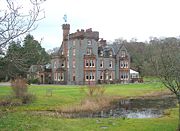
Eriska
Encyclopedia
Eriska is a flat, tidal island at the entrance to Loch Creran
on the west coast of Scotland
. Privately owned, the island is run as a hotel with wooded grounds. The island is evidently populated although no record for the total was provided by the 2001 census.
and slate
with the lower ground to the west as a raised beach. To the east of the bridge, there is a partly submerged Crannog
, or fortified dwelling, dating from the Bronze Age around 200 B.C. It is part of the Lynn of Lorn National Scenic Area
, one of 40 in Scotland.
 Eriska House was built in 1884 by the Stewarts of Appin. Built in the Scottish Baronial style by architect Hippolyte Blanc
Eriska House was built in 1884 by the Stewarts of Appin. Built in the Scottish Baronial style by architect Hippolyte Blanc
, who was highly acclaimed for his meticulous attention to detail and for a very high degree of specification in materials.
Eriska was occupied by the Blairs and Clark Hutchisons, who built the bridge over the drying channel, connecting the island to the mainland at all states of the tide. When they left in 1930 little upkeep was done until the island was purchased by the Buchanan-Smith family in 1973. The house remains essentially the same with the surrounding buildings converted to become part of the hotel.
Loch Creran
Loch Creran is a sea loch in Argyll, on the west coast of Scotland. It is about long from its head at Invercreran to its mouth on the Lynn of Lorne, part of Loch Linnhe. The loch separates the areas of Benderloch to the south and Appin to the north. The island of Eriska lies at the mouth of the...
on the west coast of Scotland
Scotland
Scotland is a country that is part of the United Kingdom. Occupying the northern third of the island of Great Britain, it shares a border with England to the south and is bounded by the North Sea to the east, the Atlantic Ocean to the north and west, and the North Channel and Irish Sea to the...
. Privately owned, the island is run as a hotel with wooded grounds. The island is evidently populated although no record for the total was provided by the 2001 census.
Geography
The island is largely of schistSchist
The schists constitute a group of medium-grade metamorphic rocks, chiefly notable for the preponderance of lamellar minerals such as micas, chlorite, talc, hornblende, graphite, and others. Quartz often occurs in drawn-out grains to such an extent that a particular form called quartz schist is...
and slate
Slate
Slate is a fine-grained, foliated, homogeneous metamorphic rock derived from an original shale-type sedimentary rock composed of clay or volcanic ash through low-grade regional metamorphism. The result is a foliated rock in which the foliation may not correspond to the original sedimentary layering...
with the lower ground to the west as a raised beach. To the east of the bridge, there is a partly submerged Crannog
Crannog
A crannog is typically a partially or entirely artificial island, usually built in lakes, rivers and estuarine waters of Scotland and Ireland. Crannogs were used as dwellings over five millennia from the European Neolithic Period, to as late as the 17th/early 18th century although in Scotland,...
, or fortified dwelling, dating from the Bronze Age around 200 B.C. It is part of the Lynn of Lorn National Scenic Area
National Scenic Area
National Scenic Area is a designation for areas of natural beauty used by more than one nation.* National Scenic Area * National Scenic Area * National scenic areas in Taiwan* National Scenic Area...
, one of 40 in Scotland.
Eriska House

Hippolyte Blanc
Hippolyte Jean Blanc was a Scottish architect. Best known for his church buildings in the Gothic revival style, Blanc was also a keen antiquarian who oversaw meticulously researched restoration projects.-Early life:...
, who was highly acclaimed for his meticulous attention to detail and for a very high degree of specification in materials.
Eriska was occupied by the Blairs and Clark Hutchisons, who built the bridge over the drying channel, connecting the island to the mainland at all states of the tide. When they left in 1930 little upkeep was done until the island was purchased by the Buchanan-Smith family in 1973. The house remains essentially the same with the surrounding buildings converted to become part of the hotel.

